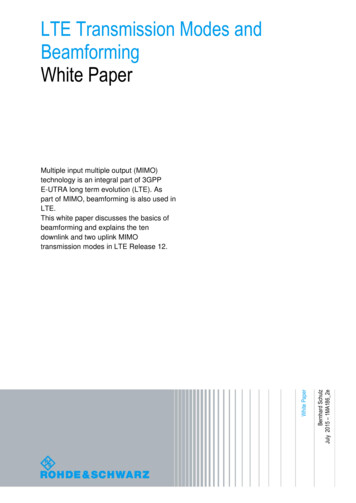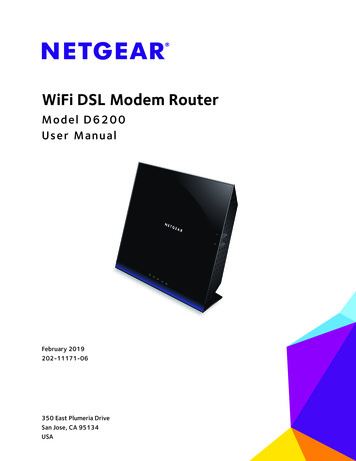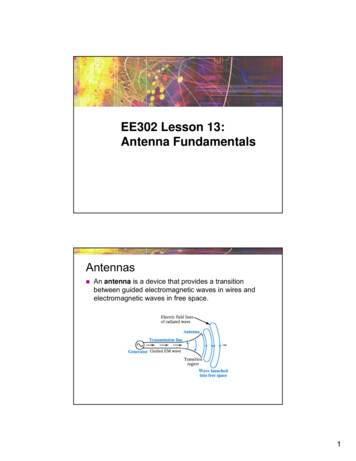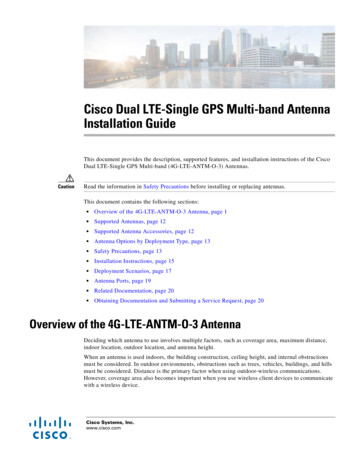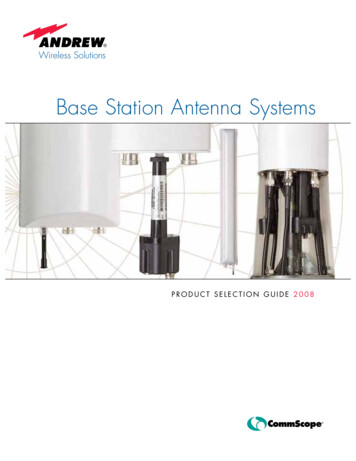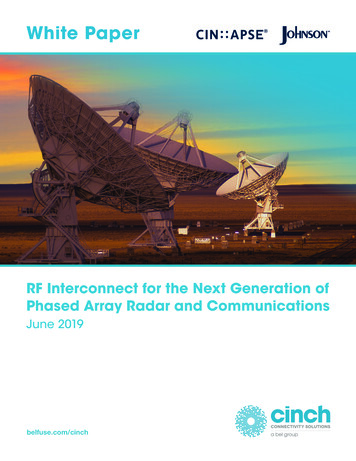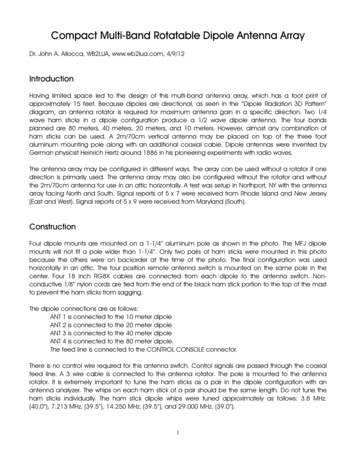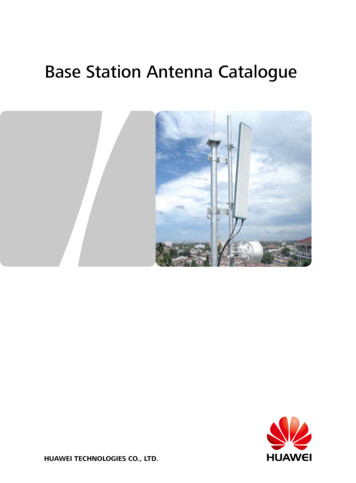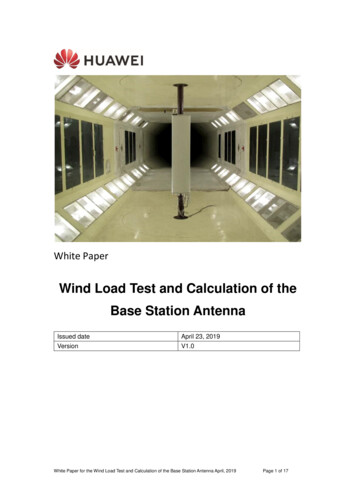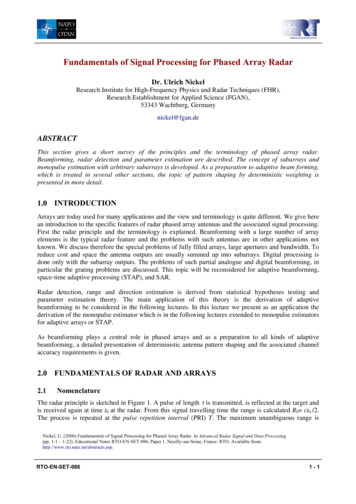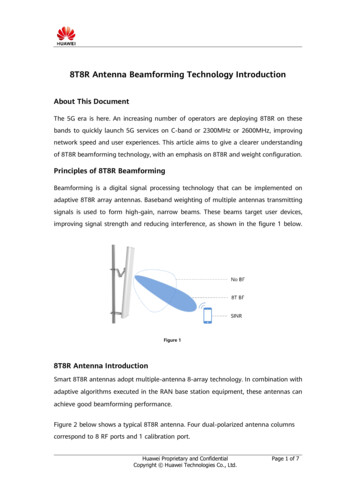
Transcription
8T8R Antenna Beamforming Technology IntroductionAbout This DocumentThe 5G era is here. An increasing number of operators are deploying 8T8R on thesebands to quickly launch 5G services on C-band or 2300MHz or 2600MHz, improvingnetwork speed and user experiences. This article aims to give a clearer understandingof 8T8R beamforming technology, with an emphasis on 8T8R and weight configuration.Principles of 8T8R BeamformingBeamforming is a digital signal processing technology that can be implemented onadaptive 8T8R array antennas. Baseband weighting of multiple antennas transmittingsignals is used to form high-gain, narrow beams. These beams target user devices,improving signal strength and reducing interference, as shown in the figure 1 below.Figure 18T8R Antenna IntroductionSmart 8T8R antennas adopt multiple-antenna 8-array technology. In combination withadaptive algorithms executed in the RAN base station equipment, these antennas canachieve good beamforming performance.Figure 2 below shows a typical 8T8R antenna. Four dual-polarized antenna columnscorrespond to 8 RF ports and 1 calibration port.Huawei Proprietary and ConfidentialCopyright Huawei Technologies Co., Ltd.Page 1 of 7
8T8R antenna Structure:4 arrays for 8 RF ports and onecalibration portFigure 2The eight RF ports on the antenna are connected to eight individual RF channels. EachRF channel uses the corresponding single column beam to radiate energy.In order to achieve high accuracy of the weighted signals at the antenna connectionpoints, which is necessary to ensure the desired radiation patterns, calibration isrequired. Even though the weighted signals are accurately provided by the basebandand RF equipment connected to the antenna, changes to the signal at the antennaconnection ports can be caused by the cabling between radio and antenna. In order toremove any influence from the cabling, calibration is performed through a dedicatedcalibration port. The amplitude and phase of the signal at each of the eight RF ports iscontinuously calibrated, removing RF signal differences caused by the cables connectingthe antenna with the radio equipment. This enables beam forming with consistentlyhigh accuracy.Currently, there are two main types of TDD 8T8R antenna. Take Huawei antennas asan example.ItemFDD TDD Converged AntennaTDD antenna (8T8R only)Antenna ModelAOC4518R8v06ATD4516R8AntennaBottom CapHuawei Proprietary and ConfidentialCopyright Huawei Technologies Co., Ltd.Page 2 of 7
8T8R Antenna Beams IntroductionSingle column beam: Each RF channel uses the corresponding single column beam toradiate energy. Baseband weighting is used to configure different changes to theamplitude and phase for each of the RF ports, in order to form broadcast and servicebeams of specific patterns and directions. Unweighted single columns are typically usedfor uplink receive channels.Beamforming for broadcast channels: Fixed-weight beamforming is used to processthe broadcast channel, control channel, and reference signals of all user devices in acell. Different fixed antenna weights (amplitude and phase) can be configured tochange the coverage scope of the broadcast beams, improving cell coverageperformance.Beamforming for service channels: PDSCH dynamic adaptive beamforming is used foruser devices. Narrow beams are formed in order to concentrate energy on target userdevices and reduce interference to surrounding user devices. The beamforming is basedon TDD uplink and downlink channel reciprocity and uplink channel measurements.This increases the demodulation SINR for target user devices and improves cell-edgeperformance.Single column beam: Beam of each column (RF port 1 8). Used in combination to form differentbeams.Broadcast beam: Used for downlink SS-PBCH[*]transmission, covering the whole sector. 5G NR: a set of narrow beams whichpoint to different directions. HuaweigNodeB use four narrow beams thattogether form the coverage area. TDD LTE: a fixed 65 beam.Huawei Proprietary and ConfidentialCopyright Huawei Technologies Co., Ltd.Page 3 of 7
Service beam: Dynamic beam adaptively formed fordownlink data transmission for eachindependent user.[*] SS-PBCH: Synchronization Signal/ Physical Broadcast Channel, contain synchronization signal and system basicinformation. E.g. system frame number, band width, antenna informationDifference between Broadcast and Service BeamsBroadcast beams determine the coverage area. 5G NR broadcast beams are differentfrom 4G LTE broadcast beams: 5G NR uses four discrete fixed narrow beams periodicallyscanning data transmission, while 4G LTE uses one fixed 65 beam continuouslytransmitting data. Service beams are used for data transmission.Broadcast BeamApplicationscenarioRelated logicalchannelBeamcharacteristicsDynamic orstaticTransmissionperiodService BeamContains common information for all userdevicesContains specific informationfor independent user devicesBroadcast channel, control channel, andcommon reference signalService channel and specificreference signal (for example,the DMRS [*])Fixed pattern for all user devices; covers thewhole sectorDifferent patterns for individualuser devicesStatic and cell specific. Single beam (LTE)or set of discrete predefined beams (NR).Dynamic and user specific.Periodic transmission (5G NR)Aperiodic, event-triggeredThe baseband unit dynamicallycalculates beams based on userdevices' channel conditions.Continuous transmission (4G LTE)30201040506070Typical beampattern80900 21 00-100110-110120-1201305G NR4G LTE-130140-140150160170180-170-160-150[*] DMRS is short for dedicated demodulation reference signal, which is a reference signal for the PUSCH.Huawei Proprietary and ConfidentialCopyright Huawei Technologies Co., Ltd.Page 4 of 7
How Beams are FormedEach RF channel uses the corresponding single column beam to radiate energy. 8T8Rbeamforming in the baseband configures different RF channel weights, consisting ofchanges to amplitude and phase of the signals for each of the eight RF ports. Theresulting radiation of the combined weighted antenna columns forms broadcast- andservice beams of specific patterns and directions, as illustrated in figure 3 below.Figure 3Weight ConfigurationAs described above, 8T8R antenna signal weighting can be applied across the RF ports.By using different weighting factors, the antenna radiation characteristics such ascoverage of broadcast- and service beams can be changed.Broadcast Beam Weight ConfigurationUsually RAN equipment suppliers use BBU and OMC (operation and maintenancecenter) to get and configure broadcast beam weights. Some suppliers have otheroptions to manage weighting factors. For example, Huawei eNodeB (TDD LTE) alsosupports a RAE (Remote Antenna Extension) based solution for configuring broadcastbeam weights.The first solution is that default broadcast beam weights are written into the BBU byitself and will be activated when configuring 8T8R beamforming.Huawei Proprietary and ConfidentialCopyright Huawei Technologies Co., Ltd.Page 5 of 7
The second solution is that antenna weighting factors are imported to OMC of the basestation. BBU will activate the weight information delivered from OMC.The third solution is usually used in some particular scenarios in TDD LTE 8T8R, likeforming the beam from 65 beam width to 33 beam width for highway coverage.This solution is a cooperative solution of RAN and antenna: A RAE device is used tostore antenna weight information in an antenna, available from factory delivery. ThenBBU automatically reads and configures the weighting factors stored in the RAE device.The data transfer is performed according to the AISG protocol, as shown in figure 4below.Figure 4Huawei 5G NR RAN currently supports to configure weights in BBU, and is expected tosupport other solutions in future.Service Beam Weight ConfigurationBecause of TDD uplink and downlink radio channel reciprocity, base stations cancalculate the downlink service channel weights through the uplink channel as follows:Step 1: The user device transmits sounding reference signals (SRS) in an uplink channel.The uplink SRS is a standard reference signal specified in 3GPP specifications and canbe identified by base station receivers.Step 2: All of the base station’s receive channels simultaneously receive the SRS. Theradio propagation channel and antenna array alter the amplitude and phase of thesignal obtained by each receive channel. Based on these received signals, the basestation estimates and calculates each received SRS. Through this, the amplitude andHuawei Proprietary and ConfidentialCopyright Huawei Technologies Co., Ltd.Page 6 of 7
phase changes caused by the radio propagation channel and the antenna arraycorresponding to each channel for the signal is obtained.Step 3: The amplitude and phase of each channel are adjusted using the weights foreach channel’s downlink data. When all channels simultaneously transmit the data thathas been adjusted using the respective weights, based on TDD channels' uplink anddownlink reciprocity, the radio propagation channels and the antenna arrays alter theamplitude and phase of the downlink signals. Those alterations are the same as in theuplink. Therefore, the combined signal resulting from those individually transmittedsignals, received by the user equipment, is optimized for signal strength andinterference. Figure 5 below illustrates this principle.Figure 5Huawei Proprietary and ConfidentialCopyright Huawei Technologies Co., Ltd.Page 7 of 7
network speed and user experiences. This article aims to give a clearer understanding of 8T8R beamforming technology, with an emphasis on 8T8R and weight configuration. Principles of 8T8R Beamforming . Beamforming is a digital signal processing technology that can be implemented on adaptive 8T8R array antennas.
